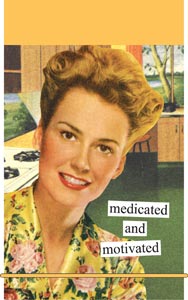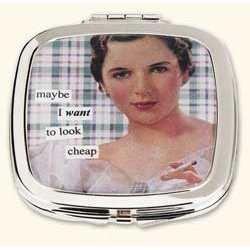 Taking a look at retro & vintage images of female domesticity (or the sales of such) is a fascinating part of my collecting.
Taking a look at retro & vintage images of female domesticity (or the sales of such) is a fascinating part of my collecting.
For every bit of useful information (research help, household tips & recipes), there is the moment of shocking disgust that even though you already knew of its existence (or at least expected to find something like that there) results in the auditory combination of frontal forehead slap and an “arg!”
This sport has become quite popular, even among the non-collecting set, who have exploited the kitsch of yesteryear & reclaimed it in the names of feminism and/or capitalism, spawning a bajillion blogs and inspiring Anne Taintor, among others.
And we buy it by the barrel. From “Guess Where I’m Tattooed” emery boards to sticky notes; from blank journals & greeting cards to ID cases & compacts.
Derogatory statements & words (like the B-word, bitch) were often reclaimed by women, much like the N-word; only we women could use those words, label one another & our products with them.
Obviously, sometimes, it was pure capitalism. Perhaps even with a pinch of misogyny — or at least irony — as it was men like Ed Polish & Darren Wotz who really capitalized on women’s mockery of their own history by selling them bold & defiant sayings juxtaposed with domesticated retro images of women.
At some point whatever genuine interest there may have been in giving females a hearty last laugh at female history was perverted into a glut of raunchy retro styled products which twisted & sometimes down-right confused sexism with sexy. At first, it felt only natural to mock & rebel against the ridiculous notion of woman as virgin & then (married) mother — with never a thought to her own pleasure or desires.
So, much like the B-word, we took over the S-word, co-opting it for our own use, putting “slut” on a slew of merchandise.
Bur then we went too far, I think, including putting “slut” on clothing for kids. *gasp* (No, I won’t link to or promote any of that.)
 Most of the retro rebelling merchandise has it’s only value in the humor, being poor product inside slick packaging, and they often don’t stick around long.
Most of the retro rebelling merchandise has it’s only value in the humor, being poor product inside slick packaging, and they often don’t stick around long.
Products such as Bitch & Slut Body Detergents are no longer are around (hello, collectible!) — but in the specific case of the body detergents, the problem was with the icky gritty soap, not the packaging. (And it should be noted, in the interests of accuracy and equality, that Mabel’s LaundrOmat also served silly, dirty & derogatory soaps about men too.) However, it seems the company continues to make stereotypical sundries which may chafe & chap those without the ability to laugh at things such as Extra High Maintenance & Extra Dizzy Blond Lip Balm.
Today, it’s difficult to enter a hip gift shop, bookstore, or boutique and not be bombarded with such humorous merch. A lot of it is funny. But some of it seems to actually be reinforcing the old myths & stereotypes. And many of the profits in the process of using humor to free women from the humiliating shackles of the past are lining the pockets of men, not women… Is that really liberating? Or funny?
I wonder about that stuff when I buy it for my collection. Because even while I may be “documenting history” (and modern items are both “today” and “history”), I don’t want to be buying the old party line when I buy my trinkets, you know?
Anyway, when you look at it all on the shelves, at a store or in a collector’s home, all this reclamation of womanhood says something… I’m just not sure what yet.







Hi Deanna, I got a Google alert on this, and first of all, thanks for the very kind and insightful review. I also really appreciate the commentary you’re making in this post. I never thought about this–vintage female imagery co-opted for the purpose of turning it right back for, at best, perpetuating language that reinforces stereotypes, and at worst, mysogyny. I explore such gender issues in much of my artwork, so it was bracing and refreshing to read your thoughts. To be honest, when I started the book, I didn’t even realize that a retr/vintage craze was going on. I’ve collected 1940s/1950s imagery for a long time because I find the design so beautiful, and because the imagery is so iconic. I think the images can be quite metaphorical; we revisit that era as a “simpler time,” and assume that women were happy in their limited roles. Untrue, I think.
Even though advertisers worked very hard to reinforce the status quo of marriage as an end and women in the home, the content of major women’s magazines told a different story. Magazines like Ladies Home Journal, Women’s Home Companion, Glamour, and Charm, among others from that era, which were highly influential, contained many serious articles on all manner of subjects—art, politics, and yes, careers. Much, much more so than women’s magazines today, which are basically one long advertorial, punctuated with occasional marital advice and celebrity interviews. It looks like between the drivel offered to women in mainstream print media, and the above images that you reference, media and culture are still conspiring to keep a certain status quo in women’s live.
Kudos to you, and thanks again!
Hi Nava,
You should have an email from me by now (explaining the visiting family & slow replies), but I’ll try to make a few quick comments here too…
I’m thrilled to find another vintage magazine addict! I read each & every page of mine, and while I can’t say we collect/own the same publications &/or issues, I have very mixed reactions to my old magazines…
I blog about that at several places & will continue to do so, but my reactions are often different than yours. I find that little of the content today is new or that different from ‘back then’ — both dictate a societal standard, pandering to placate norms & peddle product. And, in fact, I sometimes find the men’s mags less derogatory to women then women’s mags are — perhaps this is because you ‘expect’ to find stereotypes and objectification in/by men, but when women do it to one another… We should (and I hope we will, Nava) have a long conversation (or 20!) about this.
And I did not mean to imply that your book was ‘cashing in on a trend.’ At least not in a negatively commercialized fashion. I found your book cheeky & snarky & spot on. Primarily such a trend to look back (romantically and judgmentally) is to be expected (passage of time, additional & growing interest on just how far women have come, iconic imagery, etc.) and I do think your book is inspired by such things — exactly as I like it! But some people have, as I said, sort of taken the meat of the issue out, leaving us with just a bite (into our wallets & our identities). To be clear, I don’t put you or your work in that latter category. And I do (often enough) still collect such less meaty things because it too is a part of the process, the questions I have with my collecting… I don’t profess to have all the questions even articulated yet, let alone any real answers. ;) And that is part of the motivation for my collection(s).
Again, a big subject worthy of more talk :p